

Compact Muon Solenoid
LHC, CERN
| CMS-PAS-BPH-23-005 | ||
| Search for CP violation in D0→K0SK0S decay from proton-proton collisions at 13 TeV | ||
| CMS Collaboration | ||
| 26 March 2024 | ||
| Abstract: A search is reported for CP violation in the D0→K0SK0S decay, using data collected from proton-proton collisions at √s= 13 TeV recorded by the CMS experiment in 2018. A dedicated data set of about 10 billion events containing a pair of b hadrons, nearly all of which decay to charm hadrons, is used. The flavor of the neutral D meson is determined by the pion charge in the reconstructed decays D∗+→D0π+ and D∗−→¯D0π−. The CP asymmetry in D0→K0SK0S is measured to be ACP(K0SK0S)= 6.2 ± 3.0 (stat) ± 0.2 (syst) ± 0.8 (ACP(K0Sπ+π−)) %, where the last uncertainty is the CP asymmetry in the D0→K0Sπ+π− decay. This result is consistent with no CP violation within 2 standard deviations. This is the first measurement of CP violation in the charm sector by the CMS experiment, and the first measurement of CP asymmetry in the fully hadronic final state performed by CMS at the nominal LHC luminosity, using the new data parking technique. | ||
|
Links:
CDS record (PDF) ;
CADI line (restricted) ;
These preliminary results are superseded in this paper, Submitted to EPJC. The superseded preliminary plots can be found here. |
||
| Figures | |
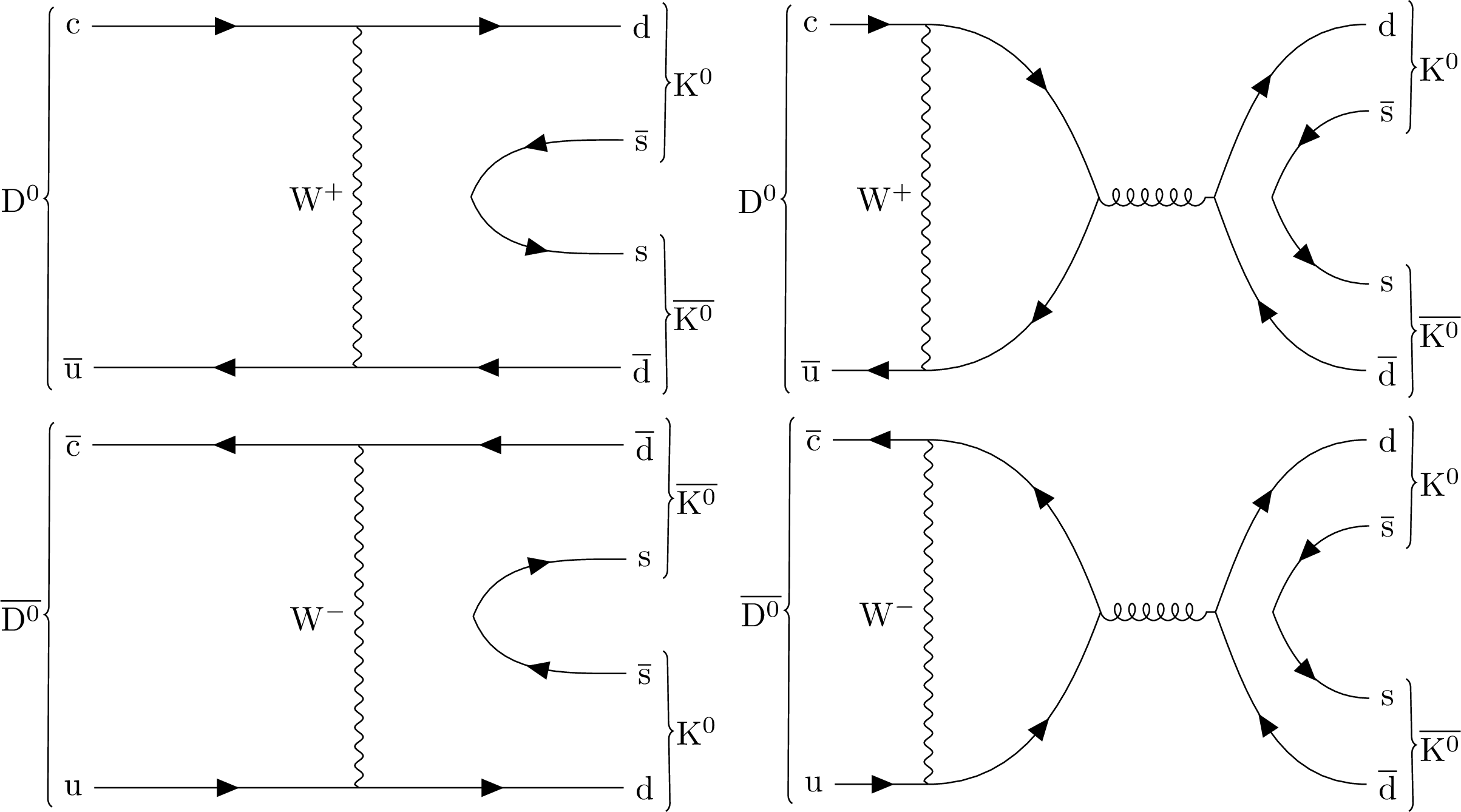
png pdf |
Figure 1:
The decay of neutral charm meson D0 (top) or ¯D0 (bottom) to two neutral kaons: exchange diagram (left) and penguin annihilation diagram (right). |
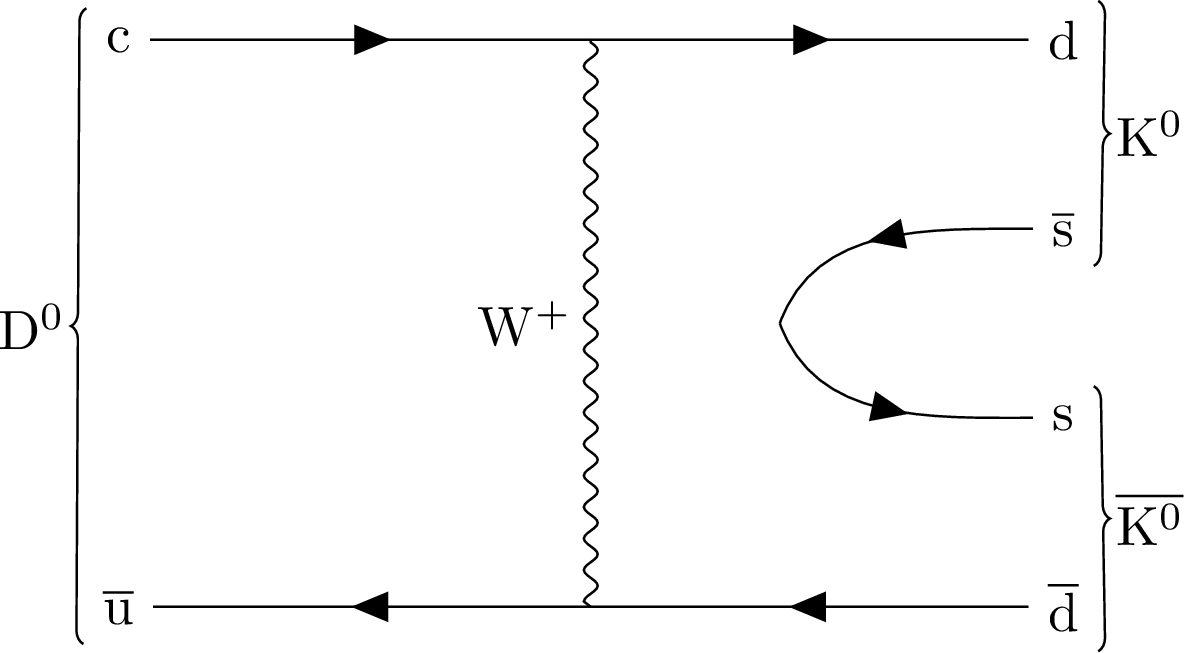
png pdf |
Figure 1-a:
The decay of neutral charm meson D0 (top) or ¯D0 (bottom) to two neutral kaons: exchange diagram (left) and penguin annihilation diagram (right). |

png pdf |
Figure 1-b:
The decay of neutral charm meson D0 (top) or ¯D0 (bottom) to two neutral kaons: exchange diagram (left) and penguin annihilation diagram (right). |

png pdf |
Figure 1-c:
The decay of neutral charm meson D0 (top) or ¯D0 (bottom) to two neutral kaons: exchange diagram (left) and penguin annihilation diagram (right). |
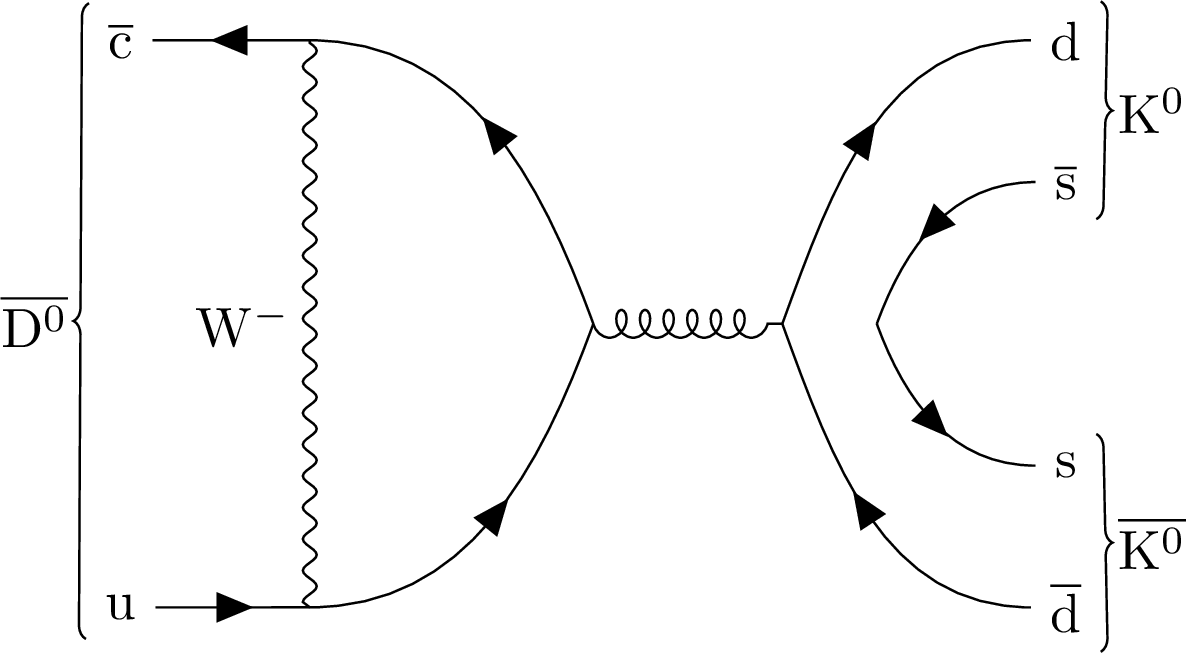
png pdf |
Figure 1-d:
The decay of neutral charm meson D0 (top) or ¯D0 (bottom) to two neutral kaons: exchange diagram (left) and penguin annihilation diagram (right). |
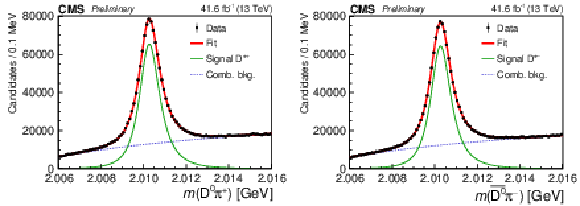
png pdf |
Figure 2:
Simultaneous fit of the D∗+ (left) and D∗− (right) candidate invariant mass distributions in the K0Sπ+π− channel. |

png pdf |
Figure 2-a:
Simultaneous fit of the D∗+ (left) and D∗− (right) candidate invariant mass distributions in the K0Sπ+π− channel. |
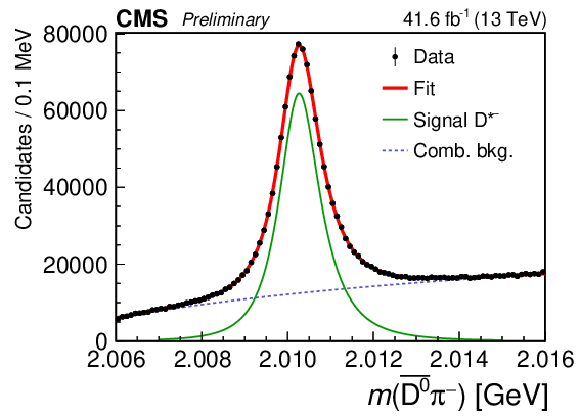
png pdf |
Figure 2-b:
Simultaneous fit of the D∗+ (left) and D∗− (right) candidate invariant mass distributions in the K0Sπ+π− channel. |

png pdf |
Figure 3:
Results of the 2D fit to m(Dπ±)× m(K0SK0S) distribution for the signal channel, for D∗+ (left) and D∗− (right) candidates: projections of the 2D fit on the m(Dπ±) (top) and m(K0SK0S) (bottom) axes. |

png pdf |
Figure 3-a:
Results of the 2D fit to m(Dπ±)× m(K0SK0S) distribution for the signal channel, for D∗+ (left) and D∗− (right) candidates: projections of the 2D fit on the m(Dπ±) (top) and m(K0SK0S) (bottom) axes. |

png pdf |
Figure 3-b:
Results of the 2D fit to m(Dπ±)× m(K0SK0S) distribution for the signal channel, for D∗+ (left) and D∗− (right) candidates: projections of the 2D fit on the m(Dπ±) (top) and m(K0SK0S) (bottom) axes. |

png pdf |
Figure 3-c:
Results of the 2D fit to m(Dπ±)× m(K0SK0S) distribution for the signal channel, for D∗+ (left) and D∗− (right) candidates: projections of the 2D fit on the m(Dπ±) (top) and m(K0SK0S) (bottom) axes. |
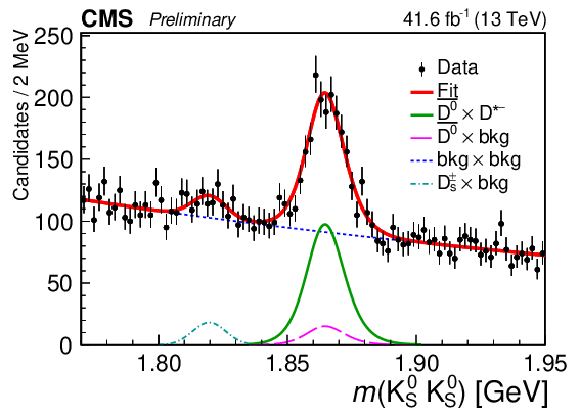
png pdf |
Figure 3-d:
Results of the 2D fit to m(Dπ±)× m(K0SK0S) distribution for the signal channel, for D∗+ (left) and D∗− (right) candidates: projections of the 2D fit on the m(Dπ±) (top) and m(K0SK0S) (bottom) axes. |

png pdf |
Figure 4:
Results of the 2D fit to m(Dπ±):m(K0SK0S) for the signal channel in measured data, D∗+ candidates. Top row: the projections of the 2D fit on m(Dπ±) in the ranges of m(K0SK0S): region of D±s→K0SK0Sπ± contamination (left) and signal region of K0SK0S (right). Middle row: projections of the 2D fit on m(Dπ±) in the ranges of m(K0SK0S): left sideband (left) and right sideband (right). Bottom row: projections of the 2D fit on m(K0SK0S) in the ranges of m(Dπ±): left sideband (left), signal region of D0π+ (center), and right sideband (right). The green line corresponds to the signal component, the blue short-dashed line shows the combinatorial background, the purple long-dashed line shows the combinations of D0 with background pions, and the magenta dash-dotted line illustrates the contamination of D±s→K0SK0Sπ± decay. |

png pdf |
Figure 4-a:
Results of the 2D fit to m(Dπ±):m(K0SK0S) for the signal channel in measured data, D∗+ candidates. Top row: the projections of the 2D fit on m(Dπ±) in the ranges of m(K0SK0S): region of D±s→K0SK0Sπ± contamination (left) and signal region of K0SK0S (right). Middle row: projections of the 2D fit on m(Dπ±) in the ranges of m(K0SK0S): left sideband (left) and right sideband (right). Bottom row: projections of the 2D fit on m(K0SK0S) in the ranges of m(Dπ±): left sideband (left), signal region of D0π+ (center), and right sideband (right). The green line corresponds to the signal component, the blue short-dashed line shows the combinatorial background, the purple long-dashed line shows the combinations of D0 with background pions, and the magenta dash-dotted line illustrates the contamination of D±s→K0SK0Sπ± decay. |
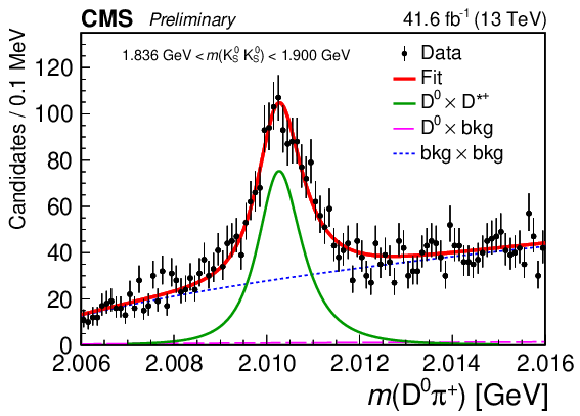
png pdf |
Figure 4-b:
Results of the 2D fit to m(Dπ±):m(K0SK0S) for the signal channel in measured data, D∗+ candidates. Top row: the projections of the 2D fit on m(Dπ±) in the ranges of m(K0SK0S): region of D±s→K0SK0Sπ± contamination (left) and signal region of K0SK0S (right). Middle row: projections of the 2D fit on m(Dπ±) in the ranges of m(K0SK0S): left sideband (left) and right sideband (right). Bottom row: projections of the 2D fit on m(K0SK0S) in the ranges of m(Dπ±): left sideband (left), signal region of D0π+ (center), and right sideband (right). The green line corresponds to the signal component, the blue short-dashed line shows the combinatorial background, the purple long-dashed line shows the combinations of D0 with background pions, and the magenta dash-dotted line illustrates the contamination of D±s→K0SK0Sπ± decay. |

png pdf |
Figure 4-c:
Results of the 2D fit to m(Dπ±):m(K0SK0S) for the signal channel in measured data, D∗+ candidates. Top row: the projections of the 2D fit on m(Dπ±) in the ranges of m(K0SK0S): region of D±s→K0SK0Sπ± contamination (left) and signal region of K0SK0S (right). Middle row: projections of the 2D fit on m(Dπ±) in the ranges of m(K0SK0S): left sideband (left) and right sideband (right). Bottom row: projections of the 2D fit on m(K0SK0S) in the ranges of m(Dπ±): left sideband (left), signal region of D0π+ (center), and right sideband (right). The green line corresponds to the signal component, the blue short-dashed line shows the combinatorial background, the purple long-dashed line shows the combinations of D0 with background pions, and the magenta dash-dotted line illustrates the contamination of D±s→K0SK0Sπ± decay. |

png pdf |
Figure 4-d:
Results of the 2D fit to m(Dπ±):m(K0SK0S) for the signal channel in measured data, D∗+ candidates. Top row: the projections of the 2D fit on m(Dπ±) in the ranges of m(K0SK0S): region of D±s→K0SK0Sπ± contamination (left) and signal region of K0SK0S (right). Middle row: projections of the 2D fit on m(Dπ±) in the ranges of m(K0SK0S): left sideband (left) and right sideband (right). Bottom row: projections of the 2D fit on m(K0SK0S) in the ranges of m(Dπ±): left sideband (left), signal region of D0π+ (center), and right sideband (right). The green line corresponds to the signal component, the blue short-dashed line shows the combinatorial background, the purple long-dashed line shows the combinations of D0 with background pions, and the magenta dash-dotted line illustrates the contamination of D±s→K0SK0Sπ± decay. |
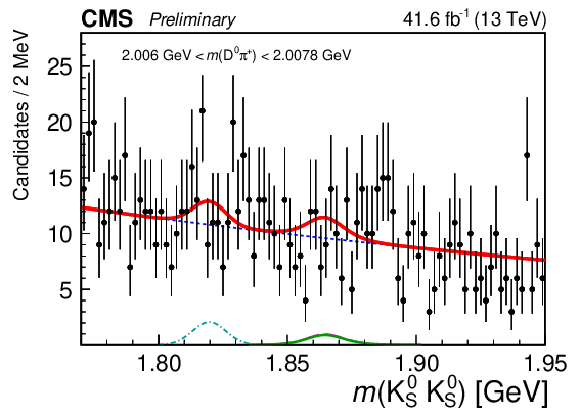
png pdf |
Figure 4-e:
Results of the 2D fit to m(Dπ±):m(K0SK0S) for the signal channel in measured data, D∗+ candidates. Top row: the projections of the 2D fit on m(Dπ±) in the ranges of m(K0SK0S): region of D±s→K0SK0Sπ± contamination (left) and signal region of K0SK0S (right). Middle row: projections of the 2D fit on m(Dπ±) in the ranges of m(K0SK0S): left sideband (left) and right sideband (right). Bottom row: projections of the 2D fit on m(K0SK0S) in the ranges of m(Dπ±): left sideband (left), signal region of D0π+ (center), and right sideband (right). The green line corresponds to the signal component, the blue short-dashed line shows the combinatorial background, the purple long-dashed line shows the combinations of D0 with background pions, and the magenta dash-dotted line illustrates the contamination of D±s→K0SK0Sπ± decay. |

png pdf |
Figure 4-f:
Results of the 2D fit to m(Dπ±):m(K0SK0S) for the signal channel in measured data, D∗+ candidates. Top row: the projections of the 2D fit on m(Dπ±) in the ranges of m(K0SK0S): region of D±s→K0SK0Sπ± contamination (left) and signal region of K0SK0S (right). Middle row: projections of the 2D fit on m(Dπ±) in the ranges of m(K0SK0S): left sideband (left) and right sideband (right). Bottom row: projections of the 2D fit on m(K0SK0S) in the ranges of m(Dπ±): left sideband (left), signal region of D0π+ (center), and right sideband (right). The green line corresponds to the signal component, the blue short-dashed line shows the combinatorial background, the purple long-dashed line shows the combinations of D0 with background pions, and the magenta dash-dotted line illustrates the contamination of D±s→K0SK0Sπ± decay. |

png pdf |
Figure 4-g:
Results of the 2D fit to m(Dπ±):m(K0SK0S) for the signal channel in measured data, D∗+ candidates. Top row: the projections of the 2D fit on m(Dπ±) in the ranges of m(K0SK0S): region of D±s→K0SK0Sπ± contamination (left) and signal region of K0SK0S (right). Middle row: projections of the 2D fit on m(Dπ±) in the ranges of m(K0SK0S): left sideband (left) and right sideband (right). Bottom row: projections of the 2D fit on m(K0SK0S) in the ranges of m(Dπ±): left sideband (left), signal region of D0π+ (center), and right sideband (right). The green line corresponds to the signal component, the blue short-dashed line shows the combinatorial background, the purple long-dashed line shows the combinations of D0 with background pions, and the magenta dash-dotted line illustrates the contamination of D±s→K0SK0Sπ± decay. |

png pdf |
Figure 5:
Results of the 2D fit to m(Dπ±):m(K0SK0S) for the signal channel in measured data, D∗− candidates. Top row: the projections of the 2D fit on m(Dπ±) in the ranges of m(K0SK0S): region of D±s→K0SK0Sπ± contamination (left) and signal region of K0SK0S (right). Middle row: projections of the 2D fit on m(Dπ±) in the ranges of m(K0SK0S): left sideband (left) and right sideband (right). Bottom row: projections of the 2D fit on m(K0SK0S) in the ranges of m(Dπ±): left sideband (left), signal region of ¯D0π− (center), and right sideband (right). The green line corresponds to the signal component, the blue short-dashed line shows the combinatorial background, the purple long-dashed line shows the combinations of ¯D0 with background pions, and the magenta dash-dotted line illustrates the contamination of D±s→K0SK0Sπ± decay. |

png pdf |
Figure 5-a:
Results of the 2D fit to m(Dπ±):m(K0SK0S) for the signal channel in measured data, D∗− candidates. Top row: the projections of the 2D fit on m(Dπ±) in the ranges of m(K0SK0S): region of D±s→K0SK0Sπ± contamination (left) and signal region of K0SK0S (right). Middle row: projections of the 2D fit on m(Dπ±) in the ranges of m(K0SK0S): left sideband (left) and right sideband (right). Bottom row: projections of the 2D fit on m(K0SK0S) in the ranges of m(Dπ±): left sideband (left), signal region of ¯D0π− (center), and right sideband (right). The green line corresponds to the signal component, the blue short-dashed line shows the combinatorial background, the purple long-dashed line shows the combinations of ¯D0 with background pions, and the magenta dash-dotted line illustrates the contamination of D±s→K0SK0Sπ± decay. |
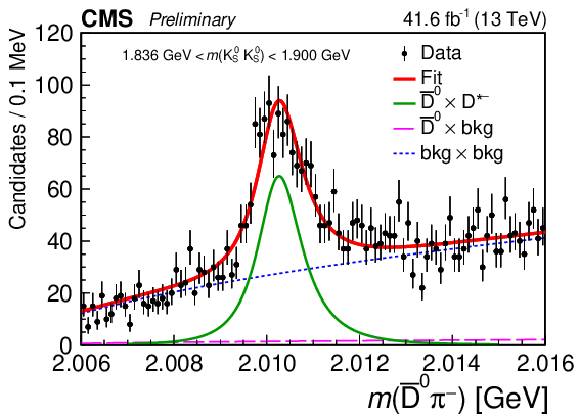
png pdf |
Figure 5-b:
Results of the 2D fit to m(Dπ±):m(K0SK0S) for the signal channel in measured data, D∗− candidates. Top row: the projections of the 2D fit on m(Dπ±) in the ranges of m(K0SK0S): region of D±s→K0SK0Sπ± contamination (left) and signal region of K0SK0S (right). Middle row: projections of the 2D fit on m(Dπ±) in the ranges of m(K0SK0S): left sideband (left) and right sideband (right). Bottom row: projections of the 2D fit on m(K0SK0S) in the ranges of m(Dπ±): left sideband (left), signal region of ¯D0π− (center), and right sideband (right). The green line corresponds to the signal component, the blue short-dashed line shows the combinatorial background, the purple long-dashed line shows the combinations of ¯D0 with background pions, and the magenta dash-dotted line illustrates the contamination of D±s→K0SK0Sπ± decay. |
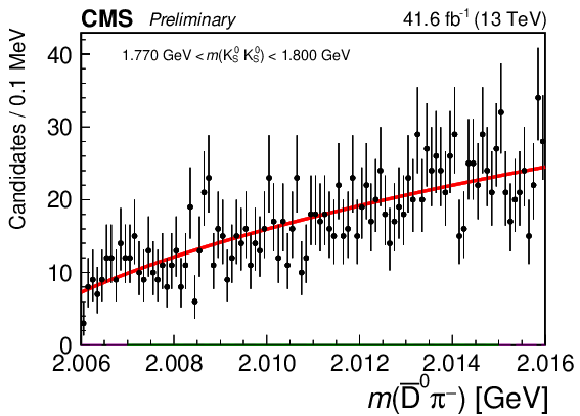
png pdf |
Figure 5-c:
Results of the 2D fit to m(Dπ±):m(K0SK0S) for the signal channel in measured data, D∗− candidates. Top row: the projections of the 2D fit on m(Dπ±) in the ranges of m(K0SK0S): region of D±s→K0SK0Sπ± contamination (left) and signal region of K0SK0S (right). Middle row: projections of the 2D fit on m(Dπ±) in the ranges of m(K0SK0S): left sideband (left) and right sideband (right). Bottom row: projections of the 2D fit on m(K0SK0S) in the ranges of m(Dπ±): left sideband (left), signal region of ¯D0π− (center), and right sideband (right). The green line corresponds to the signal component, the blue short-dashed line shows the combinatorial background, the purple long-dashed line shows the combinations of ¯D0 with background pions, and the magenta dash-dotted line illustrates the contamination of D±s→K0SK0Sπ± decay. |
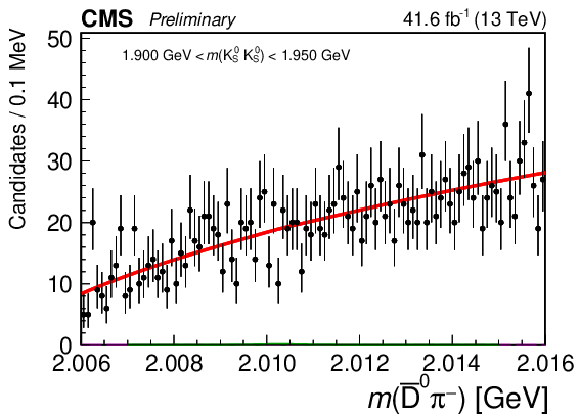
png pdf |
Figure 5-d:
Results of the 2D fit to m(Dπ±):m(K0SK0S) for the signal channel in measured data, D∗− candidates. Top row: the projections of the 2D fit on m(Dπ±) in the ranges of m(K0SK0S): region of D±s→K0SK0Sπ± contamination (left) and signal region of K0SK0S (right). Middle row: projections of the 2D fit on m(Dπ±) in the ranges of m(K0SK0S): left sideband (left) and right sideband (right). Bottom row: projections of the 2D fit on m(K0SK0S) in the ranges of m(Dπ±): left sideband (left), signal region of ¯D0π− (center), and right sideband (right). The green line corresponds to the signal component, the blue short-dashed line shows the combinatorial background, the purple long-dashed line shows the combinations of ¯D0 with background pions, and the magenta dash-dotted line illustrates the contamination of D±s→K0SK0Sπ± decay. |
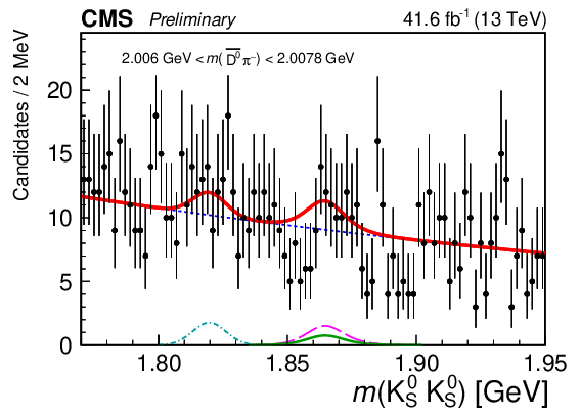
png pdf |
Figure 5-e:
Results of the 2D fit to m(Dπ±):m(K0SK0S) for the signal channel in measured data, D∗− candidates. Top row: the projections of the 2D fit on m(Dπ±) in the ranges of m(K0SK0S): region of D±s→K0SK0Sπ± contamination (left) and signal region of K0SK0S (right). Middle row: projections of the 2D fit on m(Dπ±) in the ranges of m(K0SK0S): left sideband (left) and right sideband (right). Bottom row: projections of the 2D fit on m(K0SK0S) in the ranges of m(Dπ±): left sideband (left), signal region of ¯D0π− (center), and right sideband (right). The green line corresponds to the signal component, the blue short-dashed line shows the combinatorial background, the purple long-dashed line shows the combinations of ¯D0 with background pions, and the magenta dash-dotted line illustrates the contamination of D±s→K0SK0Sπ± decay. |
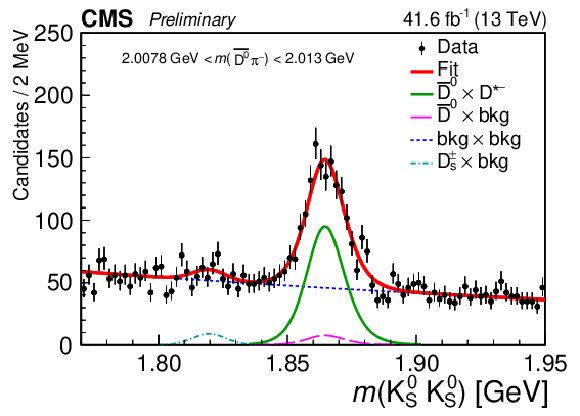
png pdf |
Figure 5-f:
Results of the 2D fit to m(Dπ±):m(K0SK0S) for the signal channel in measured data, D∗− candidates. Top row: the projections of the 2D fit on m(Dπ±) in the ranges of m(K0SK0S): region of D±s→K0SK0Sπ± contamination (left) and signal region of K0SK0S (right). Middle row: projections of the 2D fit on m(Dπ±) in the ranges of m(K0SK0S): left sideband (left) and right sideband (right). Bottom row: projections of the 2D fit on m(K0SK0S) in the ranges of m(Dπ±): left sideband (left), signal region of ¯D0π− (center), and right sideband (right). The green line corresponds to the signal component, the blue short-dashed line shows the combinatorial background, the purple long-dashed line shows the combinations of ¯D0 with background pions, and the magenta dash-dotted line illustrates the contamination of D±s→K0SK0Sπ± decay. |
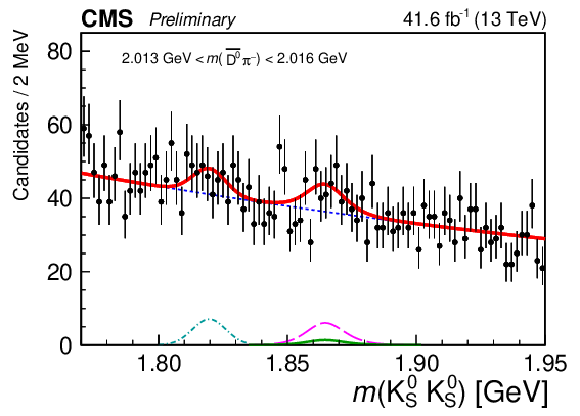
png pdf |
Figure 5-g:
Results of the 2D fit to m(Dπ±):m(K0SK0S) for the signal channel in measured data, D∗− candidates. Top row: the projections of the 2D fit on m(Dπ±) in the ranges of m(K0SK0S): region of D±s→K0SK0Sπ± contamination (left) and signal region of K0SK0S (right). Middle row: projections of the 2D fit on m(Dπ±) in the ranges of m(K0SK0S): left sideband (left) and right sideband (right). Bottom row: projections of the 2D fit on m(K0SK0S) in the ranges of m(Dπ±): left sideband (left), signal region of ¯D0π− (center), and right sideband (right). The green line corresponds to the signal component, the blue short-dashed line shows the combinatorial background, the purple long-dashed line shows the combinations of ¯D0 with background pions, and the magenta dash-dotted line illustrates the contamination of D±s→K0SK0Sπ± decay. |
| Tables | |
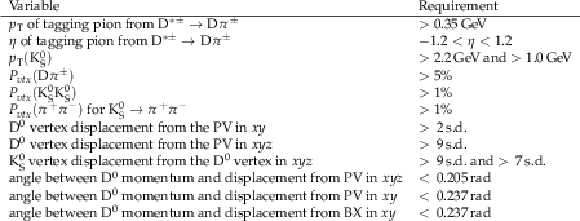
png pdf |
Table 1:
Optimized selection criteria in the signal channel D0→K0SK0S. |

png pdf |
Table 2:
Results of the simultaneous fit to the selected D∗+→D0π+ and D∗−→¯D0π− candidates, where D0(¯D0)→K0Sπ+π−. The D∗(2010)± signal yields N given in the second column are used in the evaluation of ArawCP. The uncertainties are statistical only. |

png pdf |
Table 3:
Results of the simultaneous 2D fit to the selected D∗+→D0π+ and D∗−→¯D0π− candidates, where D0(¯D0)→K0SK0S. The yields N given in the second column correspond to the D0×D∗(2010)± component in the 2D fit and are used in the evaluation of ArawCP. The χ2 corresponds to the fit projection with 100 bins in the x=m(Dπ±) axis and 90 bins in the y=m(K0SK0S) axis, as shown in Fig 3. The uncertainties are statistical only. |
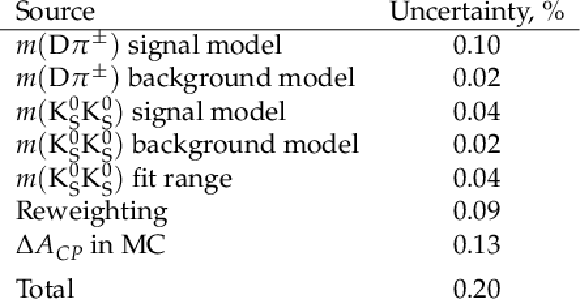
png pdf |
Table 4:
Absolute systematic uncertainties in the measurement of ΔACP. |
| Summary |
| This is the first CMS measurement of CP violation in the charm sector, paving the way for future measurements with more data, using refined techniques, and in different channels. |
| References | ||||
| 1 | A. D. Sakharov | Violation of CP invariance, C asymmetry, and baryon asymmetry of the universe | Sov. Phys. Usp. 34 (1991) 392 | |
| 2 | N. Cabibbo | Unitary symmetry and leptonic decays | PRL 10 (1963) 531 | |
| 3 | M. Kobayashi and T. Maskawa | CP-violation in the renormalizable theory of weak interaction | Progress of Theoretical Physics 49 (1973) 652 | |
| 4 | J. H. Christenson, J. W. Cronin, V. L. Fitch, and R. Turlay | Evidence for the 2 π decay of the K02 meson | PRL 13 (1964) 138 | |
| 5 | KTeV Collaboration | Observation of direct CP violation in KS,L→ππ decays | PRL 83 (1999) 22 | hep-ex/9905060 |
| 6 | The NA48 Collaboration | A precise measurement of the direct CP violation parameter Re(ε′/ε) | Eur. Phys. J. C. 22 (2001) 231 | hep-ex/0110019 |
| 7 | BABAR Collaboration | Observation of CP violation in the B0 meson system | PRL 87 (2001) 091801 | hep-ex/0107013 |
| 8 | The Belle Collaboration | Observation of large CP-violation in the neutral B meson system | PRL 87 (2001) | hep-ex/0107061 |
| 9 | BABAR Collaboration | Direct CP violating asymmetry in B0→K+π− decays | PRL 93 (2004) 131801 | hep-ex/0407057 |
| 10 | Belle Collaboration | Evidence for direct CP violation in B0→K+π− decays | PRL 93 (2004) 191802 | hep-ex/0408100 |
| 11 | LHCb Collaboration | First observation of CP violation in the decays of B0s mesons | PRL 110 (2013) 221601 | 1304.6173 |
| 12 | LHCb Collaboration | Observation of CP violation in B±→DK± decays | PLB 712 (2012) 203 | 1203.3662 |
| 13 | A. G. Cohen, D. B. Kaplan, and A. E. Nelson | Progress in electroweak baryogenesis | Annual Review of Nuclear and Particle Science 43 (1993) 27 | hep-ph/9302210 |
| 14 | A. Riotto and M. Trodden | Recent progress in baryogenesis | Annual Review of Nuclear and Particle Science 49 (1999) 35 | hep-ph/9901362 |
| 15 | W.-S. Hou | Source of CP violation for the baryon asymmetry of the Universe | Chin. J. Phys. 47 (2009) 134 | 0803.1234 |
| 16 | S. L. Glashow, J. Iliopoulos, and L. Maiani | Weak interactions with lepton-hadron symmetry | PRD 2 (1970) 1285 | |
| 17 | LHCb Collaboration | Observation of CP violation in charm decays | PRL 122 (2019) 211803 | 1903.08726 |
| 18 | A. Lenz and G. Wilkinson | Mixing and CP violation in the charm system | Ann. Rev. Nucl. Part. Sci. 71 (2021) 59 | 2011.04443 |
| 19 | Particle Data Group Collaboration | Review of particle physics | PTEP 2022 (2022) 083C01 | |
| 20 | U. Nierste and S. Schacht | CP violation in D0→KSKS | PRD 92 (2015) 054036 | 1508.00074 |
| 21 | H.-n. Li, C.-D. Lu, and F.-S. Yu | Branching ratios and direct CP asymmetries in D→ππ decays | PRD 86 (2012) 036012 | 1203.3120 |
| 22 | H.-Y. Cheng and C.-W. Chiang | Revisiting CP violation in D→ππ and VP decays | PRD 100 (2019) 093002 | 1909.03063 |
| 23 | F. Buccella, A. Paul, and P. Santorelli | SU(3)F breaking through final state interactions and CP asymmetries in D→ππ decays | PRD 99 (2019) 113001 | 1902.05564 |
| 24 | J. Brod, A. L. Kagan, and J. Zupan | Size of direct CP violation in singly Cabibbo-suppressed D decays | PRD 86 (2012) 014023 | 1111.5000 |
| 25 | LHCb Collaboration | Measurement of CP asymmetry in D0→K0SK0S decays | PRD 104 (2021) L031102 | 2105.01565 |
| 26 | N. Dash et al. | Search for CP violation and measurement of the branching fraction in the decay D0→K0SK0S | PRL 119 (2017) 171801 | 1705.05966 |
| 27 | CDF Collaboration | Measurement of CP-violation asymmetries in D0→K0Sπ+π− | PRD 86 (2012) 032007 | 1207.0825 |
| 28 | CMS Collaboration | HEPData record for this analysis | link | |
| 29 | CMS Collaboration | Recording and reconstructing 10 billion unbiased b hadron decays in CMS | CMS Detector Performance Summary CMS-DP-2019-043, 2019 CDS |
|
| 30 | CMS Collaboration | Test of lepton flavor universality in B±→ K±μ+μ− and B±→ K±e+e− decays in proton-proton collisions at √s= 13 TeV | CMS-BPH-22-005 2401.07090 |
|
| 31 | CMS Tracker Group Collaboration | The CMS Phase-1 pixel detector upgrade | JINST 16 (2021) P02027 | 2012.14304 |
| 32 | CMS Collaboration | Track impact parameter resolution for the full pseudo rapidity coverage in the 2017 dataset with the CMS Phase-1 pixel detector | CMS Detector Performance Summary CMS-DP-2020-049, 2020 CDS |
|
| 33 | CMS Collaboration | Performance of the CMS Level-1 trigger in proton-proton collisions at √s= 13\,TeV | JINST 15 (2020) P10017 | CMS-TRG-17-001 2006.10165 |
| 34 | CMS Collaboration | The CMS trigger system | JINST 12 (2017) P01020 | CMS-TRG-12-001 1609.02366 |
| 35 | CMS Collaboration | The CMS experiment at the CERN LHC | JINST 3 (2008) S08004 | |
| 36 | T. Sjöstrand et al. | An introduction to PYTHIA 8.2 | Comput. Phys. Commun. 191 (2015) 159 | 1410.3012 |
| 37 | D. J. Lange | The EvtGen particle decay simulation package | NIM A 462 (2001) 152 | |
| 38 | CMS Collaboration | Extraction and validation of a new set of CMS PYTHIA8 tunes from underlying-event measurements | EPJC 80 (2020) 4 | CMS-GEN-17-001 1903.12179 |
| 39 | E. Barberio and Z. Was | PHOTOS --- a universal Monte Carlo for QED radiative corrections: version 2.0 | Comput. Phys. Commun. 79 (1994) 291 | |
| 40 | GEANT4 Collaboration | GEANT 4 --- a simulation toolkit | NIM A 506 (2003) 250 | |
| 41 | CMS Collaboration | CMS tracking performance results from early LHC operation | EPJC 70 (2010) 1165 | CMS-TRK-10-001 1007.1988 |
| 42 | CMS Collaboration | Description and performance of track and primary-vertex reconstruction with the CMS tracker | JINST 9 (2014) P10009 | CMS-TRK-11-001 1405.6569 |
| 43 | N. L. Johnson | Systems of frequency curves generated by methods of translation | Biometrika 36 (1949) 149 | |
| 44 | M. J. Oreglia | A study of the reactions ψ′→γγψ | PhD thesis, Stanford University, SLAC Report SLAC-R-236, 1980 link |
|
| 45 | CLEO Collaboration | Search for CP violation in D0→K0Sπ+π− | PRD 70 (2004) 091101 | hep-ex/0311033 |

|
Compact Muon Solenoid LHC, CERN |

|

|

|

|

|

|